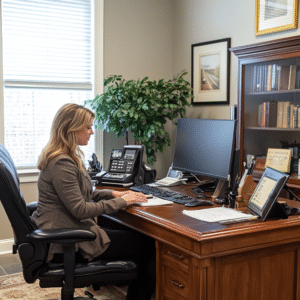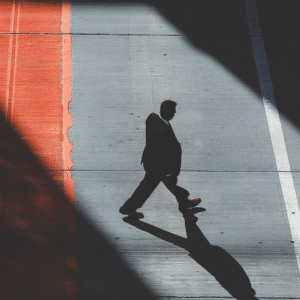
Settling a pedestrian accident claim can take anywhere from a few months to a couple of years, depending on the complexity of the case and the severity of the injuries. Many people often wonder, “How long does it take to settle a pedestrian accident?” In this article, we will explore the factors that influence this timeline and what you can expect during the process.
Key Takeaways
-
The duration of a pedestrian accident claim settlement is influenced by factors such as case complexity, injury severity, and insurance company cooperation.
-
Prompt actions, including gathering evidence, seeking immediate medical care, and hiring an experienced attorney, can expedite the claims process.
-
Understanding compensation types, including medical expenses, lost wages, and pain and suffering, is essential for ensuring fair recovery in pedestrian accident cases.

Hurt in an Accident? Hire Maguire
Hurt? You Need Our Help
Give us a call for a FREE & CONFIDENTIAL Case Review*
Key Factors Influencing Settlement Duration
The journey to a fair settlement in pedestrian accident cases can be both complex and time-consuming. The length of time it takes to settle such a claim can vary significantly based on multiple factors, including the severity of injuries, the complexity of the case, and the level of cooperation from insurance companies. Understanding these elements can help you manage your expectations and plan accordingly.
Several pivotal factors influence the duration of the settlement process. These include the intricacies of the case, the severity of injuries sustained, the degree of cooperation from the insurance company, and the various legal processes involved. Each of these factors plays a crucial role in shaping the settlement timeline, and we will explore them in detail.
Case Complexity
The complexity of a pedestrian accident case can significantly affect how long it takes to reach a settlement. Cases involving multiple parties or disputed liability often require extensive evidence gathering and detailed investigations, which can prolong the settlement timeline. For instance, if there are conflicting claims about who is at fault, the process of determining liability can be particularly time-consuming.
Moreover, complex cases that involve significant injuries or substantial financial claims typically necessitate more thorough evaluations and negotiations. The more complicated the circumstances, the longer it may take to gather the necessary evidence and reach a fair settlement.
Injury Severity
The severity of the injuries sustained in a pedestrian accident is another critical factor that influences the settlement duration. Severe injuries often require extensive medical treatment and longer recovery periods, which can delay the settlement process. For instance, if the injured victim needs ongoing medical care or physical therapy, it may take longer to reach maximum medical improvement (MMI), a key point in the settlement process.
In contrast, cases involving minor injuries might settle more quickly, sometimes within weeks. However, it’s crucial not to rush into a settlement before fully understanding the long-term implications of the injuries. Even seemingly minor injuries can have lasting effects that need to be properly evaluated.
For serious injuries, thorough medical evaluations are essential to document the full extent of the injuries and their impact on the victim’s life.
This comprehensive documentation is necessary to ensure that the injured party receives fair compensation for both current and future medical needs.
Insurance Company Cooperation
The cooperation of the insurance company can significantly impact the speed at which a pedestrian accident claim is settled. When an insurance company is willing to negotiate in good faith, the settlement process can proceed relatively quickly. However, if the insurance company adopts delaying tactics or initially offers low settlement amounts, this can extend the settlement timeline.
Insurance companies may use various strategies to slow down the process, such as disputing liability or requesting additional documentation. The willingness of the insurance adjuster to work toward a resolution plays a crucial role in determining how long it will take to settle the claim.
Legal Processes
Navigating the legal processes involved in a pedestrian accident claim can also influence the settlement timeline. These processes include gathering evidence, filing claims, and negotiating with insurers. An experienced pedestrian accident attorney can help streamline these steps, ensuring that all necessary actions are taken promptly and effectively.
Determining liability often requires collecting substantial evidence, such as police reports, witness statements, and photographs. This evidence is crucial for demonstrating negligence and establishing the facts of the case. The more thorough the legal process, the stronger the case will be, but this thoroughness can also extend the time it takes to reach a fair settlement.
Typical Settlement Points
Pedestrian accident settlements can occur at various stages of the legal process. Understanding these typical settlement points can help you anticipate potential outcomes and prepare accordingly. Filing an insurance claim is the most direct way to seek compensation. This method is often recommended for those looking to recover their losses. When liability is clear, insurance companies are more likely to settle quickly. However, a pedestrian accident settlement can also happen during negotiations or even pre-trial phases.
Different stages of the settlement process provide various opportunities for resolution. Early settlements, negotiation phases, and pre-trial settlements each have their own dynamics and timelines, which we will explore in the following subsections.
Early Settlements
Early settlements often occur when liability is clear and the injuries are straightforward. In such cases, the insurance company may offer a quick settlement to avoid the costs and uncertainties of litigation. Simple cases with evident responsibility often result in quicker settlement offers.
Clear evidence of liability, such as eyewitness accounts or video footage, can prompt insurance companies to make early settlement offers. These early settlements can be advantageous, allowing the injured party to receive compensation without prolonged legal battles.
Negotiation Phase
The negotiation phase is a critical period where both parties attempt to reach a mutual agreement. This phase can occur before or after filing a lawsuit. During negotiations, both parties present their cases, discuss the evidence, and try to find a solution that meets their respective interests.
Effective negotiation can lead to a fair settlement without the need for a trial. This phase often plays a crucial role in resolving disputes and achieving a satisfactory outcome for both parties.
Pre-Trial Settlements
Many pedestrian accident cases are resolved during the discovery phase, before going to trial. During discovery, both sides exchange information and evidence, which can clarify the strengths and weaknesses of each case. This transparency often leads to settlements, as parties prefer to avoid the uncertainties and expenses associated with a trial.
Pre-trial settlements are common because they allow both parties to control the outcome without leaving it to a judge or jury. This stage often presents a final opportunity to settle a pedestrian accident case before incurring significant legal fees and court costs.

Pedestrian Accident Lawyer? Hire Maguire
Give us a call for a FREE & CONFIDENTIAL Case Review*
How to Expedite Your Pedestrian Accident Claim
If you’re looking to expedite your pedestrian accident claim, there are several key steps you can take. Prompt action can make a significant difference in the speed and success of your claim. Taking swift action, such as collecting evidence, getting medical care immediately, and consulting with a seasoned attorney, can reduce delays and improve the likelihood of a quick settlement.
These steps are crucial in building a strong case and ensuring that all necessary documentation is in place. Let’s explore these actions in more detail.
Gather Evidence Promptly
Gathering evidence promptly after a pedestrian accident is essential for establishing clear liability and strengthening your claim. Early evidence collection can prevent the loss of crucial information and expedite the resolution of your claim. Essential evidence includes photographs of the accident scene, witness statements, and any police reports filed.
Documenting everything immediately and preserving physical evidence when possible can make a significant difference. This proactive approach ensures that you have a solid foundation for your claim and can help speed up the settlement process.
Seek Medical Attention Immediately

Accepting an initial settlement offer without understanding the full extent of your injuries can be risky. Immediate medical treatment ensures that all injuries are properly diagnosed and treated, which is vital for seeking fair compensation.
Hire an Experienced Pedestrian Accident Attorney
Hiring an experienced pedestrian accident lawyer can significantly expedite your claim and maximize your compensation for pedestrian accident victims. A knowledgeable personal injury attorney can efficiently negotiate with insurance companies, ensuring a fair settlement based on injury severity and insurer policies. Consulting a pedestrian accident attorney as soon as possible is crucial for navigating the legal process and protecting your rights.
An experienced attorney can streamline the claims process, handle all communications with insurers, and provide valuable guidance throughout your case. This legal support can make a significant difference in the outcome and speed of your claim.
Understanding Compensation in Pedestrian Accident Cases
Understanding the types of compensation available in pedestrian accident cases is essential for ensuring you receive fair compensation. Victims can claim various types of compensation, including medical bills, pain and suffering damages, lost wages, and property damage. Each type of compensation addresses different aspects of the impact of the accident on the victim’s life.
Maximum Medical Improvement (MMI) helps in estimating total medical expenses and determining compensation for ongoing pain and suffering. Let’s delve into the specific types of compensation you might be entitled to.
Medical Expenses
Medical expenses from pedestrian accidents can include immediate treatment costs and ongoing health care requirements. It’s crucial to seek medical attention immediately after the accident to document your condition and check for any injuries that may not be immediately apparent. Detailed records of medical treatments and expenses are essential for substantiating your claim and ensuring compensation for all medical costs.
Preserving medical bills, receipts for expenses, and correspondence with insurance companies is critical for substantiating your claim. These documents provide the evidence needed to claim all related medical expenses, both current and future.
Lost Wages
Lost wages compensation is calculated based on the income the victim would have earned if they had not been injured. Compensation for lost wages may account for both current losses due to missed work and future income losses resulting from permanent disabilities. Calculating lost wages involves assessing the injured party’s work history and expected earnings.
This type of compensation ensures that the injured party is not financially disadvantaged due to the accident. It is an essential component of fair compensation in personal injury cases.
Pain and Suffering
Pain and suffering compensation addresses the non-economic damages that significantly impact an accident victim’s life. Factors leading to claims for diminished quality of life include severe accidents and persistent injuries that hinder normal functioning. Recognizing pain and suffering is crucial for ensuring that victims receive fair compensation to reflect their non-economic damages.
Non-economic damages, such as emotional distress or loss of enjoyment, can significantly impact compensation. Calculating compensation for pain and suffering often involves multiplying the total economic damages by a factor ranging from 1.5 to 5.
Statute of Limitations for Pedestrian Accident Claims
The statute of limitations refers to the legal deadlines for filing a pedestrian accident claim. These timelines can differ by state, typically starting from the date of the incident or when injuries are discovered. It is critical to consult with a lawyer promptly to ensure compliance with the statute of limitations and protect your right to compensation.
In some jurisdictions, if a pedestrian injury claim is not filed within the established limits, the court may dismiss the case regardless of its merit. Understanding these legal deadlines is crucial for preserving your claim and ensuring that you do not lose the opportunity to seek compensation.
The Role of Maximum Medical Improvement (MMI)
Maximum Medical Improvement (MMI) refers to the point at which injuries have stabilized, and the long-term impacts of the injuries are clearer. Reaching MMI is important for determining the full extent of injuries and potential compensation. It is advisable to work with an attorney until maximum medical improvement is reached to avoid losing out on future compensation.
MMI helps in negotiating with insurance companies by clarifying the extent of injuries, potentially strengthening the claimant’s position. This ensures that all future medical needs and ongoing pain and suffering are accounted for in the settlement.
Frequently Asked Questions
How long does it typically take to settle a pedestrian accident claim?
Typically, settling a pedestrian accident claim can take anywhere from a few weeks to several months or even years, depending on factors such as case complexity, injury severity, and insurance cooperation. It is essential to consider these variables when estimating the timeline for your specific situation.
What is Maximum Medical Improvement (MMI), and why is it important?
Maximum Medical Improvement (MMI) is the stage at which an individual’s injuries have stabilized and no further recovery is anticipated. This assessment is vital as it establishes the full extent of injuries, aiding in the determination of appropriate compensation for medical expenses and suffering.
How can I expedite my pedestrian accident claim?
To expedite your pedestrian accident claim, promptly gather evidence, seek immediate medical attention, and hire an experienced attorney. These actions will significantly strengthen your case and reduce potential delays in the settlement process.
What types of compensation can I claim in a pedestrian accident case?
In a pedestrian accident case, you can claim compensation for medical expenses, lost wages, and pain and suffering, each addressing the various impacts of the accident on your life. It is important to evaluate these factors to ensure you pursue the appropriate compensation.
What is the statute of limitations for filing a pedestrian accident claim?
The statute of limitations for filing a pedestrian accident claim typically varies by state, beginning from the date of the incident or the discovery of injuries. It is advisable to consult a lawyer promptly to safeguard your right to compensation.
Last updated Tuesday, October 7th, 2025





